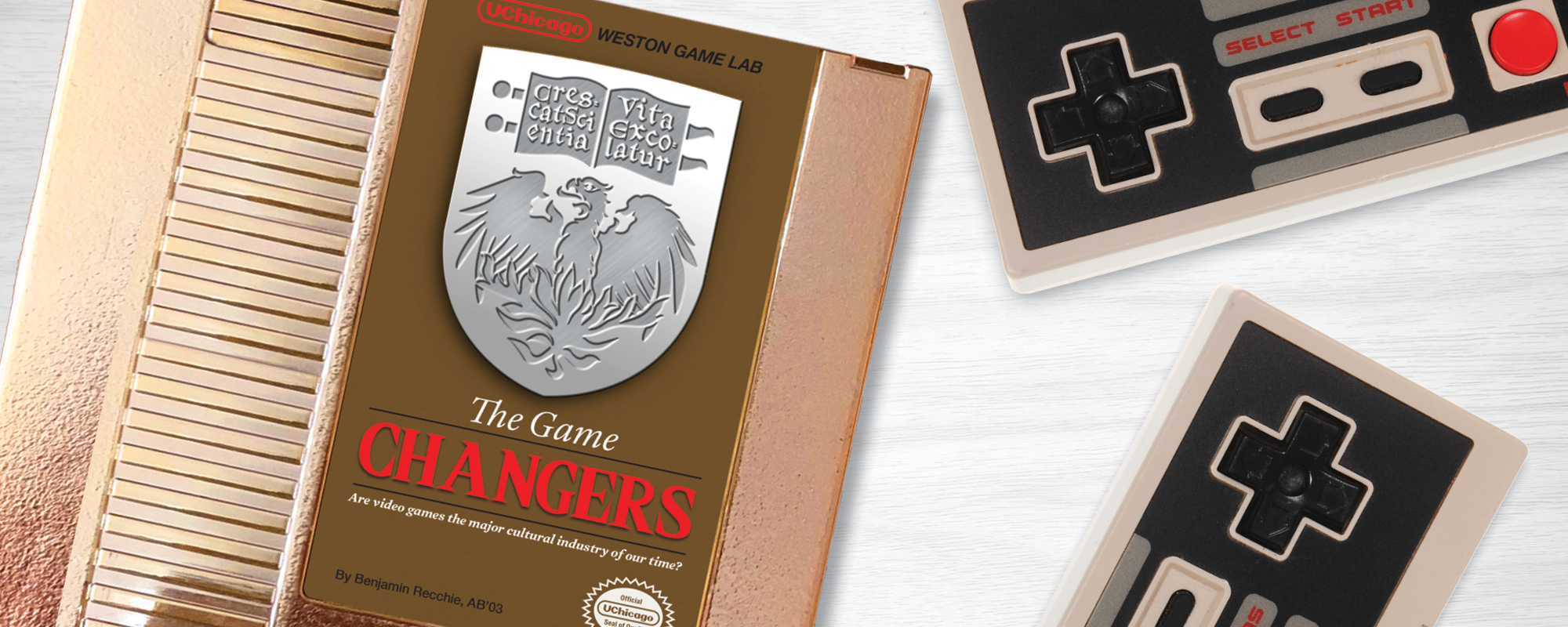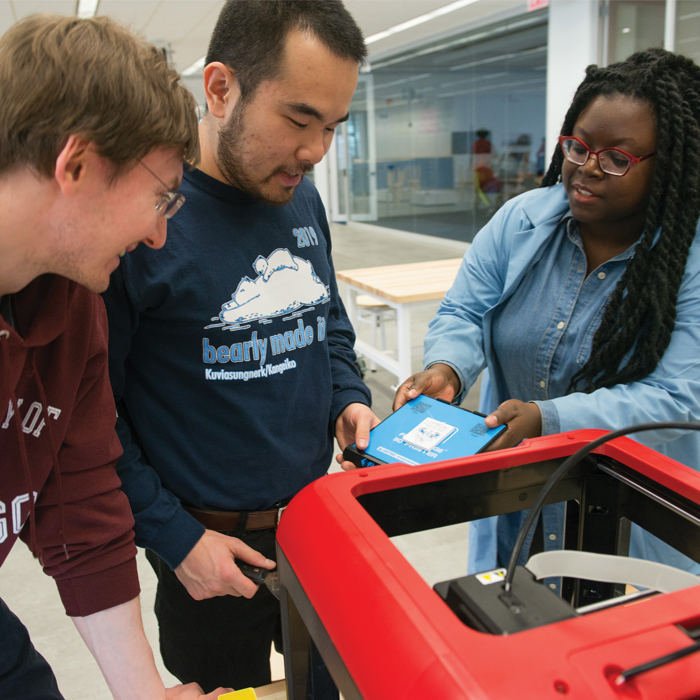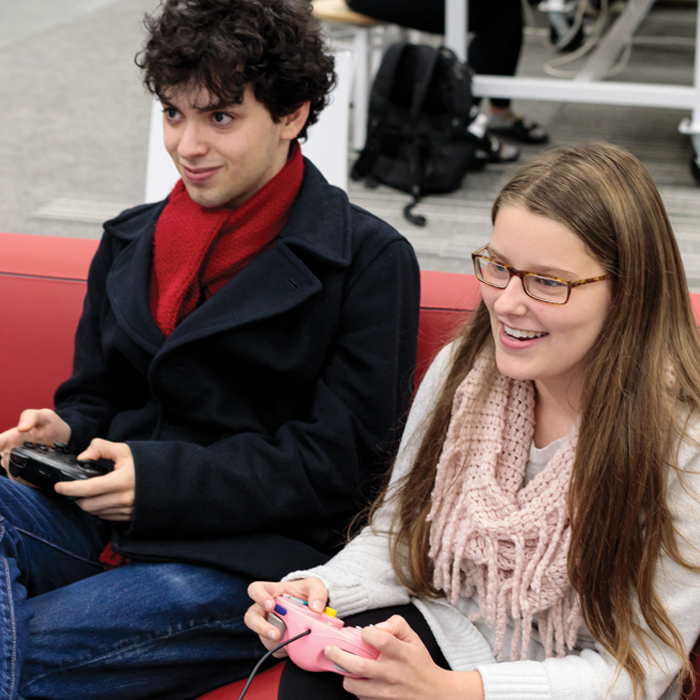
(Photo illustration by Michael Vendiola; photography by CTRPhotos)
Are video games the major cultural industry of our time?
The lecture hall at 5727 South University Avenue is handsome and restrained, the perfect setting for an instructor in a tweedy jacket to lecture on ethics, or perhaps Tolstoy’s view of history. But today several dozen students, roughly evenly split between men and women, have convened for something weightier: ENGL 12320, Critical Videogame Studies.
Patrick Jagoda, professor of English and cinema and media studies and director of the Weston Game Lab, opens by asking the students to turn to their neighbor. They’re to spend two minutes discussing the homework assignment: trying out The Stanley Parable (2011), a single-player game centered on an office drone looking for his missing coworkers. The room erupts in a low roar, punctuated by laughter and groans of frustration as the students recount their misadventures.
When the two minutes are over, Jagoda’s co-instructor, Ashlyn Sparrow, assistant director of the Weston Game Lab, pipes up. “I need you to put your laptops away,” she says sternly. Sparrow explains that too many people aren’t doing the readings or playing the assigned games; this quiz will keep them honest. TAs pass out the quiz, which starts with simple questions like How difficult did you find The Stanley Parable? Then, Do you think you played the game for more or less time than your partner? Then, Draw a sketch of Stanley’s face as it appears in the game. Finally, Now, draw a top hat on your image of Stanley’s face.
After Jagoda calls time, he instructs the students to hold their quiz sheets vertically in the air. They do so. I do as well, even though my quiz is blank.
Then he tells them to tear the sheet from top to bottom into two equal strips. We all do that too.
Finally, he displays a slide with discussion questions: How fully did you report on your partner? Did you draw the image of Stanley? Did you rip up your paper? Why?
The quiz is a red herring. (“I believe most of you are actually playing the games and doing the readings,” Jagoda admits.) The real lecture for the day concerns why we obey rules and instructions in games and in real life.
As the discussion unfolds, one student reveals he didn’t tear up his quiz paper: “I was proud of the work I put into it,” he says with a tinge of sheepishness. Another says she started to question the directions when asked to draw Stanley’s face, since the player never sees it. A third suggests maybe he was only willing to follow the puzzling instructions because of the nature of the class: “If it was a calculus quiz, I wouldn’t have ripped it up.”
“There are some situations when you want to follow the rules, and others when you want to disregard them,” Jagoda says. He segues into a discussion of the famous Milgram experiment, run by Yale psychologist Stanley Milgram. Under pressure, participants administered what they thought were painful electric shocks to someone pretending to be a test subject.
“This brings us to the question of whether video games can condition us to obedience,” Jagoda continues. Most early video games used on-screen instructions to help you through the game, he says, but more recently, experimental games have asked players to think about decision-making, consent, and complicity.
A student mentions an example from The Stanley Parable: at one point, the narrator tells you explicitly not to press a button, but it turns out that pressing the button is the only way to continue. Another student mentions an instruction from the game that rewards you if you turn the game off and ignore it for five years. If she complies, she wonders, is she even still playing the game? And if she abandons the game at that point with no intention to return, is she nevertheless still following its instructions?
As Jagoda wraps up the discussion, he leaves the class with one last question: “What systems in your lives are rigged games?”

Patrick Jagoda—tall, lanky, and with teal hair—looks more than a little like he stepped forth from a video game; adepts of Japanese games might note his resemblance to Hubert Oswell from Tales of Graces (2009). He earned his doctorate in English from Duke in 2010, while simultaneously earning a graduate certificate in information science and studies. At UChicago he received a two-year Mellon Postdoctoral Fellowship to study new media.
Ashlyn Sparrow came to the Weston Game Lab after studying entertainment technology at Carnegie Mellon University and Universidade da Madeira. She’s developed a score of games, many of them educational.
The seeds of the Weston Game Lab were planted in 2011 when Jagoda started working on serious games about public health—particularly adolescent sexual and reproductive health—with Melissa Gilliam, then professor in obstetrics and gynecology and in pediatrics and now also Ellen H. Block Professor of Health Justice and vice provost. Their project became the Game Changer Chicago Design Lab, which is part of the Center for Interdisciplinary Inquiry and Innovation in Sexual and Reproductive Health.
Sparrow joined the University in 2013, first as a game designer and later as the Weston Game Lab’s assistant director. Jagoda and Sparrow have been creative partners ever since. “I could not imagine so robust a media arts culture without her vibrant presence,” he says.
Although the Game Changer Chicago Design Lab focuses on public health, Jagoda and Sparrow noticed how excited the teens got about the process of designing the games. That led to the question of how to build a game design curriculum and provide a career path for interested students at UChicago. Critical Videogame Studies was one result of that; the Weston Game Lab was another.
Sparrow and Jagoda work with more games than just the video variety. The duo have a particular expertise in alternate reality games, which combine live-action and online components through transmedia narratives. “There might be a website that a player needs to navigate, or they might actually have a phone number that they found on a poster that they need to call,” Sparrow explains. “They might get a voicemail, or they might actually get in touch with a live actor.”
In 2017 Jagoda and Sparrow collaborated with University faculty (including Heidi Coleman, AM’08, senior lecturer in theater and performance studies, and Kristen Schilt, associate professor in sociology) on an alternate reality game, the parasite, for O-Week. This past summer the group created a similar orientation game, Terrarium, focused on climate change.
Terrarium required the incoming first-years to help people from four versions of 2049—played by actors—to solve puzzles and escape their predicaments. (Sparrow and Jagoda played parts as well, even dying their hair green for the roles: “I suppose you could say that this happened with extended exposure to the SPORE device,” Jagoda jokes, referencing the events of the game.) Terrarium “was inspired by video games,” Jagoda says, “but had many analog components too.”
Likewise, a major component of the Weston Game Lab is the study of tabletop games. “Students can learn fundamental game design skills through the analog components of board, card, and tabletop games, before they ever move into video game development,” Jagoda says.
The Weston Game Lab hosts regular tabletop and board game play nights. Designers of games—students and nonstudents alike—bring their new creations into the lab to play test them. One group of students created their own original tabletop role-playing game, called Wanderstruck. Two PhD students in English, Arianna Gass and Evan Wisdom-Dawson, organized a night of board games about the apocalypse that connected to both of their research interests.
But when it comes to teaching about the structure of games in general, video games are ideal for several reasons. For one, Sparrow says, “it’s easy to get these games and have our students do these close readings. They also only take a couple of hours, and you can play them individually.”
Jagoda adds, “A quarter is a very short time.” Students bring their previous video game knowledge and experience to the classroom, so they can immediately “dive into more complex materials.”
Critical studies of video games is a young field, just 30 years old or so; Jagoda estimates that only in the 21st century have games been a subject of serious academic inquiry. But video games are “arguably a major, if not the major cultural industry of our time,” he says, with an estimated 2.5 billion players worldwide. “Many of our students are growing up spending tens of hours playing video games each week. Yet they don’t have the same kind of capacity to analyze games for their graphic components, their audio elements, their mechanics and rules, and the medium-specific ways they tell stories.”
Jagoda offers, by way of example, a 2018 game they discussed in class called Return of the Obra Dinn, which is organized around logic puzzles, and set in 1807—the year Britain abolished the slave trade. “You’re on board this ship and have to figure out how all the people on the ship died. You are playing a bureaucrat, an insurance adjuster, who has to discover a precise narrative about these deaths—who should get paid out, who owes money, based on wrongdoings.” On one level, he says, “it’s just a fun logic game.” But scratch the surface, and “the game is ultimately a meditation on colonialism, finance, and slavery.”

Shellwyn Weston and Bradford Weston, JD’77, the donors who made the Weston Game Lab possible, come from the world of high finance, but they are avid gamers, particularly of the online role-playing game World of Warcraft. It’s not just a hobby: they believe well-designed games could have a major impact on society. “Gaming increasingly provides demonstrable improvements in individuals’ ability to acquire knowledge and make decisions,” said Shellwyn Weston when the lab was opened. “Moreover, I believe that augmented reality will soon emerge as a strategic imperative for corporations and an effective tool for NGOs.”
The Weston Game Lab’s physical space is but one component of the larger Media Arts, Data, and Design (MADD) Center, built in what was until recently the periodicals section of the John Crerar Library. When I visit on a rainy Saturday afternoon, the MADD Center desk clerks are playing jazz softly in the background, and several students are plugging away at their homework. A foursome plays a card-based role-playing game.
A few feet away are video screens on carts where you can hook up game consoles for individual or group play. Half a dozen College students are playing Super Smash Bros. Ultimate, the latest installment of a fighting game from Nintendo that pits characters from different video game series against each other. It’s straightforward and light of heart. There’s none of the introspection of The Stanley Parable here—just cartoon characters darting about and punching.
The Weston Game Lab is about to get a lot noisier. The weekly Smash Bros. tournament begins at 5 p.m.
As they warm up, the students graciously allow me to play. It’s particularly kind of them since (a) I don’t have a controller, (b) I’ve never played this game, and (c) I’m twice their age and inherently uncool. The MADD Center desk attendants lend me a controller, which solves problem (a). I’ve tried to address (b) by watching an instructional video on YouTube the night before, in which I learned roughly what combinations of buttons I need to mash. And I resign myself to (c).
Athan Liu, Class of 2021—one of tonight’s tournament organizers—is my opponent. First, we choose characters. Liu chooses Ganondorf, a villainous warrior-sorcerer from The Legend of Zelda. (I later learn it’s a UChicago Smash Bros. tradition for newcomers to play their first match against Ganondorf.) I choose Kirby, a friendly faced pink ball from the game series of the same name. (If you didn’t grow up playing video games, the incongruity of this matchup is probably lost on you. Think of it like Dracula versus Snoopy.) “3—2—1—GO!”
I quickly figure out how to punch, duck, jump, and ... that’s about it. Any hope I had that beginner’s luck might favor me quickly evaporates; Ganondorf repeatedly knocks Kirby off the floating platform where the fights take place. There’s too much going on for my untrained eye; I press buttons wildly. I’m inordinately proud when one of my punches lands and knocks my opponent off the platform, but it’s too little, too late. Liu wins, as we knew he would.
The group continues playing friendly matches as I slip away to speak with Jonathan Castro, SB’18, the chief tournament organizer. Castro says that in early 2019, soon after the latest iteration of Super Smash Bros. came out, a few people staged a tournament in the Reynolds Club. With the opening of the MADD Center, the tournament moved to the Weston Game Lab’s main room. It’s low stakes—each entrant pays $3, the winner gets the pot—but “people find satisfaction in being able to grow as a player and competitor.”
Many regulars also participate in Inter-Collegiate Chicago Smash, a regional tournament with 100 entrants representing local universities. At the last one, Castro notes with a hint of pride, the UChicago team won. There are even some fans: Castro explains that they stream the matches on Twitch (a live streaming service for video games). The audience isn’t big—10 to 15, he estimates, and nothing like the 600,000-plus who watched rapper Drake play Fortnite in March 2018—but it’s a start.
The organizers eventually wander away from their pickup games and start readying the room for the tournament. They move the screen we’ve just been playing on and fire up Twitch on the Weston Game Lab computers. Not many players are expected today, they tell me: it’s Family Weekend, which explains the puzzled middle-aged couples periodically being led through the space by their offspring.
By 5 p.m., only 19 players are registered. The official start time is pushed back to 5:15 to give stragglers a chance to arrive. It’s a double-elimination bracket format, but even so, it looks like they’re in for a short night.
“Do you want to sign up?” asks first-year Summer Long, running the registration desk. I shake my head. She watched me play earlier and surely knows I’m an easy mark.

“I remember my original job dinner, when I was interviewing for a postdoc at the University of Chicago in 2010,” Jagoda says. “Since the position was officially in the English department, I expected questions about American literature. In fact, we ended up talking about digital and networked games for over two hours.”
There’s a straight line between this realization—that senior scholars in his field would take games seriously—and Critical Videogame Studies and other classes on games at UChicago (see “The Game’s Afoot!” below). Scholars are quickly warming to the field, which, Jagoda notes, “was not the case even a decade ago.”
The growth in the complexity of video games—from the visual overstimulation of Super Smash Bros. to the wide-open worlds of Grand Theft Auto—has been made possible by advances in technology, both hardware and software. It’s tempting to think of these games primarily in terms of microelectronics and computer programming; in other words, as products of science and engineering. (Arguably UChicago’s most famous alum in the game industry is Alex Seropian, SB’91, cocreator of Halo—and a math major.) But Jagoda sees the games as rooted in the humanities, a product of how people play and interact with each other.
“There’s a lot of talk about the humanities being in crisis,” he says. “This narrative isn’t completely new. But when I think about a field like media arts and design, or game design, or many other emergent areas in media, the humanities feel more necessary than ever.”
Gaming has exploded as an art form in recent years, Jagoda says: board games and video games, serious and casual, played in private and as professional e-sports in front of massive audiences. “Among scholars, if not journalists, it is no longer adequate merely to trumpet the economic success of the multibillion-dollar videogame industry that now outpaces book publishing, music, and even film, or to express wonder at the possibility that video games can be art,” Jagoda says. Video games already encompass entertainment, art, education, activism, and more, and their future is a blank page, just waiting to be written on.
The game’s afoot!
There are numerous courses at UChicago that explore video games. Here are some of this year’s offerings, along with excerpted course descriptions.
ARTGAMES
Reset your expectations of video games! Video games can be political, experimental, and poetic. … Develop, hack, mod, and utilize video games as an artistic medium.
Climate Change in Media and Design
In this course, we will examine the aesthetics of climate change. … The most substantial work of the quarter will be an ambitious multimedia or transmedia project about one of the core course topics to be completed in a team.
Computers for Learning
Over time, technology has occupied an increasing role in education, with mixed results. … This course covers technology, psychology (e.g., motivation, engagement), and pedagogy (e.g., constructivism) as they apply to educational technology so that students can design and build an educational learning application.
Embodied Data and Gamified Interfaces
We produce caches of data within our networked lives, from social media interactions to mass surveillance systems. … The aesthetics of many of these interfaces uses gamification as a guise to data collection, relying on dopamine rushes from “winning” likes, shares, and views to keep us coming back. … We will explore data and games as artistic mediums and how they interface and exchange with each other.
Games and Performance
This experimental course explores the emerging genre of “immersive performance,” “alternate reality,” and “transmedia” gaming.
